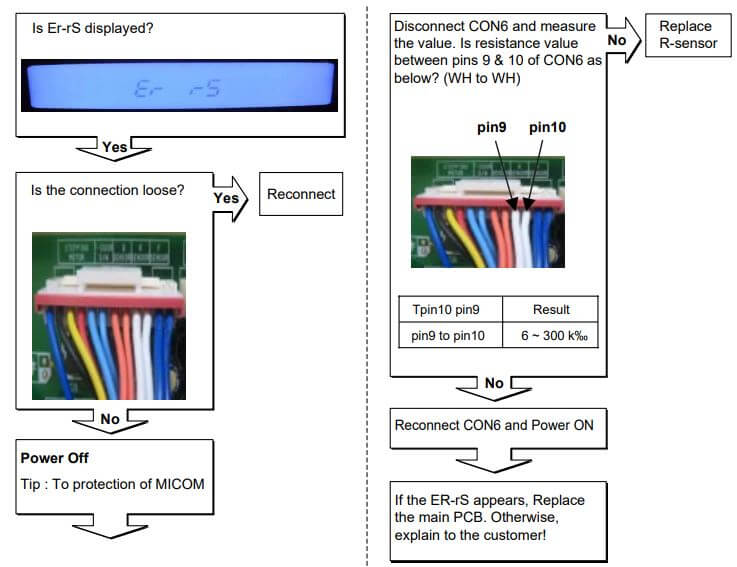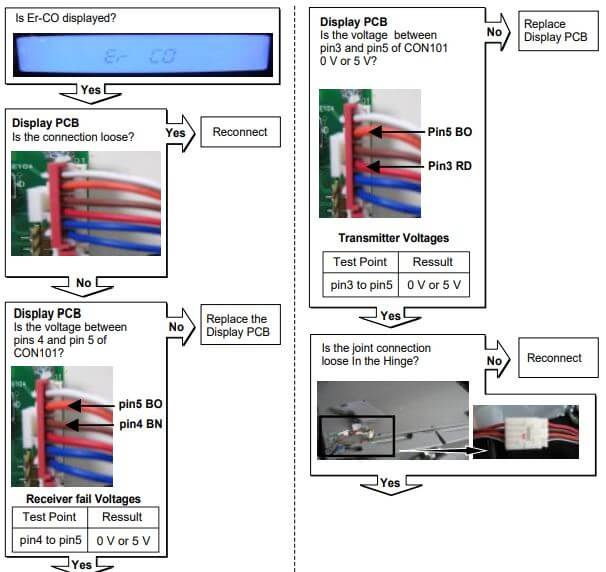
| Error Display | Error Detection Category |
|---|---|
| Er-FS | Freezer Sensor Error |
| Er-rS | Refrigerator Sensor Error |
| Er-dS | Defrosting Sensor Error |
| Er-IS | Icing Sensor Error |
| Er-dH | Poor Defrosting |
| Er-IF | Abnormality of BLDC FAN Motor for Ice Making |
| Er-FF | Abnormality of BLDC FAN Motor for Freezer |
| Er-CF | Abnormality of BLDC FAN Motor for Mechanic Room |
| Er-CO | Communication Error |
How to FiX?
When you check the Resistance values, be sure to turn off the power. And wait for the voltage-discharge sufficiently.
Error Display: Er FS
Freeze Temperature: Er
Ref. Temperature: FS
Error Generation Factors: Short or Disconnection of Freezer Sensor
Remark: Check each sensor and its connector.
Error Detection Category: Freezer Sensor Error

Error Display: Er rS
Freeze Temperature: Er
Ref. Temperature: rS
Error Generation Factors: Short or Disconnection of Refrigerator Sensor
Remark: Check each sensor and its connector.
Error Detection Category: Refrigerator Sensor Error

Error Display: Er dS
Freeze Temperature: Er
Ref. Temperature: dS
Error Generation Factors: Short or Disconnection of Defrosting Sensor
Remark: Check each sensor and its connector.
Error Detection Category: Defrosting Sensor Error

Error Display: Er IS
Freeze Temperature: Er
Ref. Temperature: IS
Error Generation Factors: Short or Disconnection of Icing Sensor
Remark: Check each sensor and its connector.
Error Detection Category: Icing Sensor Error

Error Display: Er dH
Freeze Temperature: Er
Ref. Temperature: dH
Error Generation Factors: Even though it is passed 1 hour since then Defrosting , if Defrosting sensor is not over 8°C, it is caused
Remark: Temperature Fuse Disconnection, Heater disconnection, DRAIN Jam, Poor Relay for Heater
Error Detection Category: Poor Defrosting

Error Display: Er IF
Freeze Temperature: Er
Ref. Temperature: IF
Error Generation Factors: It is caused when feedback signal isn’ t over 115 seconds during BLDC FAN motor operating
Remark: Poor BLDC Motor connection, DRIVE IC, and TR Tx/Rx between icemaker and main board.
Error Detection Category: Abnormality of BLDC FAN Motor for Ice Making

Error Display: Er FF
Freeze Temperature: Er
Ref. Temperature: FF
Error Generation Factors: It is caused when feedback signal isn’ t over 115 seconds during BLDC FAN motor operating
Remark: Poor BLDC Motor connection, DRIVE IC, and TR Tx/Rx between icemaker and main board.
Error Detection Category: Abnormality of BLDC FAN Motor for Freezer

Error Display: Er CF
Freeze Temperature: Er
Ref. Temperature: CF
Error Generation Factors: It is caused when feedback signal isn ’ t over 115 seconds during BLDC FAN motor operating
Remark: Poor BLDC Motor connection, DRIVE IC, and TR Tx/Rx between icemaker and main board.
Error Detection Category: Abnormality of BLDC FAN Motor for Mechanic Room

Error Display: Er CO
Freeze Temperature: Er
Ref. Temperature: CO
Error Generation Factors: Communication Error between Micom of Main PCB and Display Micom
Remark: Poor Communication connection,Poor TR of Transmitter and Receiver Tx/Rx between icemaker and main board.
Error Detection Category: Communication Error

Troubleshooting
Problem: Ice maker is not making any ice.
Cause:
- Ice maker wire signal arm is in the “up” or OFF position.
- Household water line valve is not open.
- Freezer is not cold enough.
- Saddle valve on cold water pipe is clogged or restricted by foreign material.
Correction:
- Move wire signal arm to the “down” or ON position (side mounted).
- Turn on household water line valve.
- See PROBLEM column TEMPERATURES ARE TOO WARM.
- Turn off household water line valve. Remove valve. Ensure that valve is not a self-piercing saddle valve. Clean valve. Replace valve if necessary.
Problem: Ice maker is not making enough ice.
Cause:
- Ice maker is producing less ice than you expect.
- Freezer is not cold enough.
- Household water line valve is not completely open.
Correction:
- The ice maker will produce 2 to 3 pounds of ice every 24 hours depending on usage conditions. Ice is produced at a rate of 8 cubes every 75 to 160 minutes.
- See PROBLEM column TEMPERATURES ARE TOO WARM.
- Turn on household water line valve.
Problem: Ice maker will not stop making ice.
Cause: Ice maker wire signal arm is being held down by some item in the freezer
Correction: Move item and release wire signal arm. Remove any ice cubes that are frozen together over the wire signal arm
Problem: Ice cubes are freezing together.
Cause:
- Ice cubes are not being used frequently enough.
- Freezer control is set too warm.
- Very little food in freezer.
Correction:
- Remove ice container and discard ice from container. Ice maker will produce fresh supply.
- Set freezer control to colder setting. Allow 24 hours for temperature to stabilize.
- Add more food to freezer.
Problem: Ice has bad odor and taste.
Cause:
- Ice has picked up odor or flavor from strong food stored in refrigerator or freezer.
- Water running to ice maker has poor taste or odor.
- Ice not used frequently enough.
Correction:
- Cover foods tightly. Discard stale ice. Ice maker will produce fresh supply. Replace air filter (available in select models).
- Add filter to water supply line. Consult a water purifying company.
- Discard stale ice.
Problem: Light bulb is not on.
Cause:
- Light bulb is burned out.
- No electric current is reaching refrigerator.
Correction:
- See Replacing Light Bulbs in NORMAL OPERATING SOUNDS section.
- See PROBLEM column RUNNING OF REFRIGERATOR.
Problem: Interior is dirty.
Cause:
- Interior needs to be cleaned.
- Food with strong odors is in refrigerator
Correction:
- See table of Care and Cleaning Tips in CARE & CLEANING section.
- Cover food tightly.
Problem: Door(s) will not close.
Cause:
- Door was closed too hard, causing other door to open slightly.
- Refrigerator is not level. It rocks on the floor when moved slightly.
Correction:
- Close both doors gently.
- Ensure floor is level and solid, and can adequately support the refrigerator. Contact a carpenter to correct a sagging or sloping floor.
Problem: Drawers are difficult to move
Cause:
- Food is touching shelf on top of drawer.
- Track that drawers slide on is dirty.
Correction:
- Remove top layer of items in drawer.
- Ensure drawer is properly installed on track.
- Clean drawer, rollers, and track. See table of Care and Cleaning Tips in CARE & CLEANING section.
Problem: Compressor does not run
Cause:
- Refrigerator is in defrost cycle.
- Plug at electrical outlet is disconnected.
- House fuse blown or tripped circuit breaker.
- Power outage.
Correction:
- This is normal for a fully automatic defrost refrigerator. The defrost cycle occurs periodically, lasting about 30 minutes.
- Ensure plug is tightly pushed into outlet.
- Check/replace fuse with a 15 amp time-delay fuse. Reset circuit breaker.
- Check house lights. Call local electric company.
Problem: Refrigerator runs too much or too long.
Cause:
- Room or outside weather is hot.
- Refrigerator has recently been disconnected for a period of time.
- Automatic ice maker is operating.
- Doors are opened too frequently or too long.
- Fresh Food/freezer door may be slightly open.
- Fresh Food/freezer gasket is dirty, worn, cracked, or poorly fitted.
Correction:
- It is normal for the refrigerator to work longer under these conditions.
- It takes 8-12 hours for the refrigerator to cool down completely.
- Ice maker operation causes refrigerator to run slightly more.
- Warm air entering the refrigerator causes it to run more. Open doors less often.
- Ensure refrigerator is level. Keep food and containers from blocking door. See PROBLEM column OPENING/ CLOSING OF DOORS/DRAWERS.
- Clean or change gasket. Leaks in door seal will cause refrigerator to run longer in order to maintain desired temperatures.
Problem: Compressor goes off and on frequently.
Cause: Thermostat keeps the refrigerator at a constant temperature.
Correction: This is normal. Refrigerator goes on and off to keep temperature constant.
Problem: Freezer temperature too cold. Fresh Food temperature is satisfactory
Cause: Freezer control is set too cold.
Correction: Set freezer control to a warmer setting. Allow 24 hours for temperature to stabilize
Problem: Fresh Food temperature too cold. Freezer temperature is satisfactory.
Cause: Fresh Food control is set too cold.
Correction: Set fresh food control to a warmer setting. Allow 24 hours for temperature to stabilize.
Problem: Food stored in drawers freezes.
Cause: Fresh Food control is set too cold.
Correction: See solution above.
Problem: Freezer/Fresh Food temperature is too warm.
Cause:
- Doors are opened too frequently or too long.
- Door is slightly open.
Correction:
- Warm air enters the refrigerator whenever the door is opened. Open the door less often.
- See PROBLEM column OPENING/ CLOSING OF DOORS/DRAWERS.
Problem: Freezer temperature is too warm. Fresh Food temperature is satisfactory.
Cause: Freezer control is set too warm.
Correction: Set freezer control to a colder setting. Allow 24 hours for temperature to stabilize.
Problem: Fresh Food temperature is too warm. Freezer temperature is satisfactory.
Cause: Fresh Food control is set too warm.
Correction: Set Fresh Food control to a colder setting. Allow 24 hours for temperature to stabilize.
Problem: Moisture collects on inside of refrigerator walls.
Cause:
- Weather is hot and humid.
- Door is slightly open.
- Door is opened too often or too long.
- Open containers.
Correction:
- The rate of frost buildup and internal sweating increases.
- See PROBLEM column OPENING/ CLOSING OF DOORS/DRAWERS.
- Open door less often.
- Keep containers covered.
Problem: Water collects on bottom side of drawer cover.
Cause: Vegetables contain and give off moisture
Correction:
- It is not unusual to have moisture on the bottom side of the cover.
- Move humidity control (some mod- els) to lower setting.
Problem: Water collects in bottom of drawer.
Cause: Washed vegetables and fruit drain while in the drawer.
Correction: Dry items before putting them in the drawer. Water collecting in bottom of drawer is normal.
Problem: Moisture collects on outside of refrigerator or between doors
Cause:
- Weather is humid.
- Door is slightly open, causing cold air from inside refrigerator to meet warm air from outside.
Correction:
- This is normal in humid weather. When humidity is lower, the moisture should disappear.
- See PROBLEM column OPENING/ CLOSING OF DOORS/DRAWERS.
Kenmore Refrigerator Manual PDF